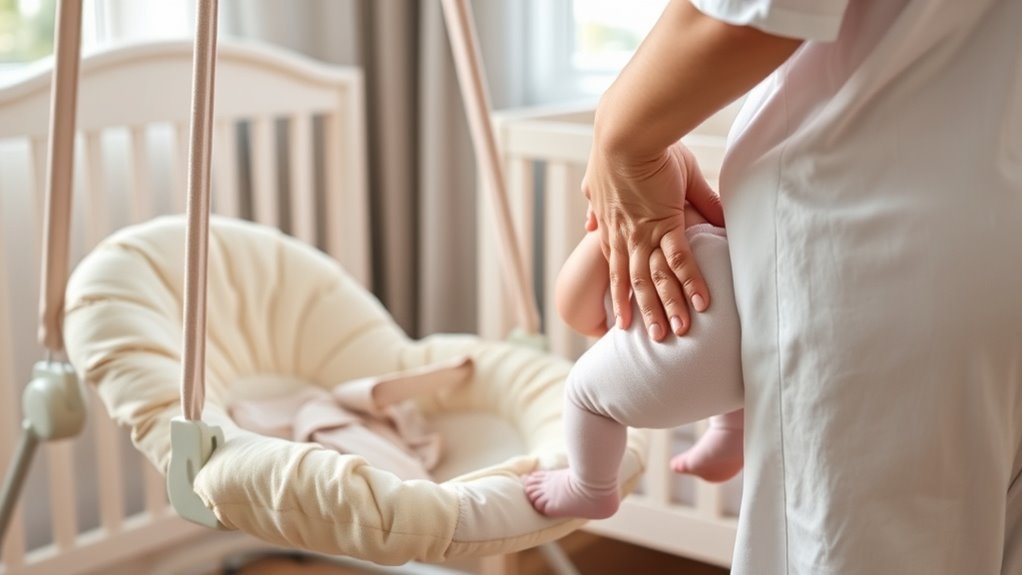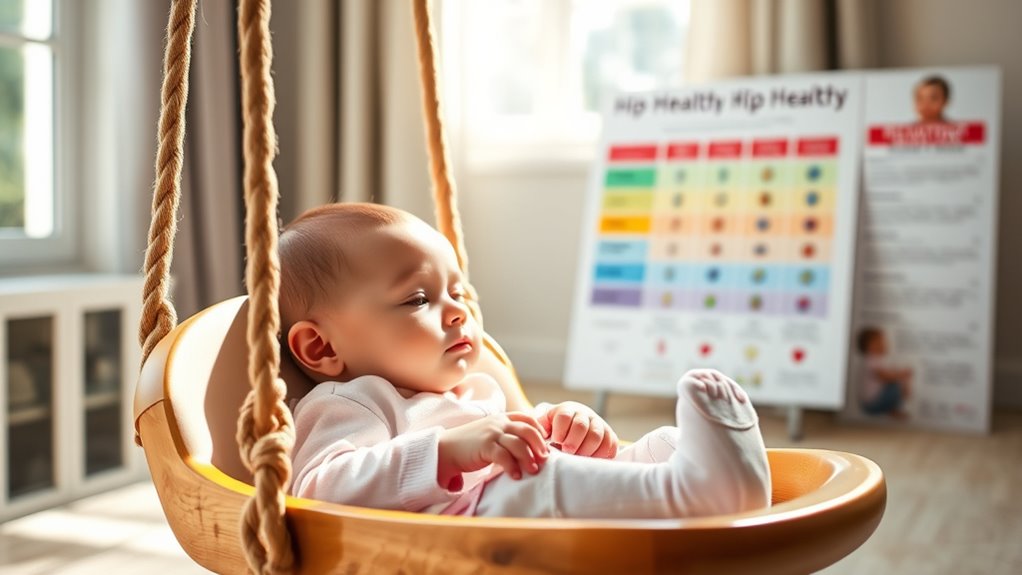Pediatricians warn that improper use of baby swings can affect your baby’s hip development. Avoid positions that force hips into curled or “frog” shapes, and limit swing time to prevent delays in milestones like crawling or walking. Choose swings that support hips in a natural, neutral position, and give your baby plenty of supervised tummy time. Staying mindful of these tips helps protect your baby’s hip health—and there’s more to contemplate if you look further.
Key Takeaways
- Ensure baby swings support hips in a neutral, spread-squat position to promote healthy hip development.
- Limit swing time and avoid prolonged use to prevent hip dysplasia and developmental delays.
- Avoid forcing hips into curled or “frog” positions; natural, supported positioning is safest.
- Combine supervised tummy time and free movement to support milestones and healthy hip growth.
- Choose swings designed to support proper hip alignment and avoid equipment that keeps hips in restrictive positions.

Baby swings are a popular tool for soothing infants, but if you’re not careful, they can impact your baby’s hip health. Many parents rely on swings to calm their little ones, but it’s vital to understand how improper use can affect developing hips, especially in babies at risk for conditions like hip dysplasia. Hip dysplasia is a condition where the hip socket doesn’t form properly, and prolonged or incorrect positioning can make matters worse. As your baby grows, their hips need room to develop naturally, which is closely tied to reaching developmental milestones like sitting, crawling, and walking. If a swing places your baby in a position that restricts hip movement or forces the hips into an unnatural position, it could delay or interfere with these milestones.
Most pediatricians recommend cautious use of swings, emphasizing that they shouldn’t be the primary place your baby spends their time. When your infant is in a swing, the hips should be in a neutral, spread-squat position—not tightly pressed together or forced into an unnatural angle. If a swing forces your baby into a curled or “frog” position, it can put undue stress on the hips, increasing the risk of developmental issues. It’s also vital to limit the amount of time spent in swings, especially for babies with a family history of hip dysplasia or those diagnosed early. The goal is to allow your baby’s hips to move freely and develop as they naturally would during supervised tummy time and other gentle activities.
Additionally, research shows that hip position during early infancy plays a crucial role in hip development, highlighting the importance of natural positioning. You should also pay close attention to the fit and design of the swing. Choose models that support the baby’s thighs and hips in a healthy, natural position. Avoid swings that keep your baby in a semi-reclined or upright position for long periods. Instead, incorporate plenty of supervised tummy time and time spent lying flat on the back or side, which promotes healthy hip development and supports reaching milestones like rolling over and sitting independently. Proper positioning in swings and other equipment is essential for preventing hip dysplasia and promoting optimal growth.
Frequently Asked Questions
How Long Can My Baby Safely Stay in a Swing Daily?
You might wonder how long your baby can stay in a swing each day. According to safety guidelines, limit use to about 30 minutes at a time to prevent overheating and promote healthy development. Keep in mind that swings shouldn’t replace tummy time and other activities that support your baby’s developmental milestones. Always watch for signs of discomfort and make sure your baby is properly supported and supervised during swing time.
Are There Specific Brands Recommended for Hip-Friendly Swings?
Choosing a hip-friendly swing is like finding a diamond in the rough, and safety features should be your guiding star. Look for brands known for their ergonomic design and adjustable recline. Recommendations often include brands like Fisher-Price, Graco, and Babybjörn, which prioritize safety and hip health. Always double-check that the swing supports proper hip positioning and complies with safety standards to keep your little one safe and comfortable.
How Can I Tell if My Baby’S Hips Are Developing Normally?
To tell if your baby’s hips are developing normally, watch for signs of hip dysplasia, like uneven leg lengths or limited movement. Regularly check if your baby reaches developmental milestones comfortably and without discomfort. Pediatricians recommend routine screenings, especially if there’s a family history. If you notice anything unusual or have concerns, consult your doctor promptly. Early detection guarantees proper treatment and supports healthy hip development.
Can Using Swings Affect My Baby’S Motor Skill Development?
You worry that swings might delay your baby’s motor milestones, but moderate use won’t harm development. While excessive swinging could increase hip dysplasia risk, responsible use helps your baby strengthen muscles and develop coordination. Short, supervised sessions support motor skills without compromising hip health. Just remember, balance is key—limit swing time and always watch for signs of discomfort or hip issues to ensure healthy growth.
When Should I Stop Using a Swing Altogether?
You should stop using the swing once your baby reaches the age or weight limit specified by safety guidelines, usually around 6 months or when they can sit unassisted. Keep an eye on developmental milestones; if your baby shows signs of trying to sit or roll, it’s time to shift away from the swing. Always prioritize safety, and don’t rely on swings for prolonged periods.
Conclusion
Just like a swing can gently cradle your baby, choosing the right position helps protect their hips. I once met a mom who switched from a traditional swing to a supportive, ergonomic one after noticing her baby’s discomfort. That simple change made all the difference, ensuring her little one’s hips stayed healthy and strong. Remember, your choices can shape your baby’s future—so swing wisely, and prioritize their hip health every time.









